Do you want to get a pet that is different and interesting? Imagine a pet salamander as an example. The wide variety of sizes, shapes and colors makes salamanders fascinating pets. It is important to know the special needs of the salamander species before deciding to get one. Choosing the best pet salamander for you is incredibly important because different species have different care needs.
This article will list seven of the greatest salamanders for folks who want a pet. You will study what makes amphibians unique and how their habitat helps them. There is information about salamanders for all kinds of pet owners, whether they are novice or experienced.
Key Takeaways
- Pet salamander makes excellent, easy-to-care-for exotic pets for people of all ages and experiences.
- Because every salamander species needs different care, it’s important to do your research.
- The top 10 pet salamanders are the Fire Salamander, Tiger Salamander and Axolotl.
- Ensure your pet salamander has a proper home with the right temperature, humidity, and an appropriate diet.
- A salamander will only do well if you are dedicated and care for it regularly over a long period.
Introduction to Pet Salamander
Pet salamanders are members of the Caudata group and that’s an interesting fact. A wide range of amphibian species are included in this group. A lot of people are attracted to their unique looks and behaviors. There are over 700 salamander species on Earth, which means they can appear very different.
What Makes Salamanders Great Pets
Anyone who likes amphibians will find that having a pet salamander is different from other pets. They need less care than some of the other exotic pets you can find. Because they don’t get excited easily, they are fun to observe and learn from. Because there are so many pet salamander types to choose from, you can find one that’s perfect for you and your home.
Also, most pet salamanders are gentle and don’t need as much attention as certain pets do. That means they’re convenient for anyone short on time. It’s both enjoyable and soothing to watch a pet salamander act in its natural home.
Understanding Salamander Care Requirements
It’s essential to find out what your pet salamander needs to be healthy before bringing one home. Every kind of salamander requires different habitats, meals, temperatures and humidity. When you know about the caudata classification and where your salamander is from, you can build a better home for it.
To have a good home for a salamander, think about the room’s size, the ground or bedding, hiding spots and plants. Proper temperature and humidity are necessary to ensure your pets are happy and healthy. Giving them adequate food, cleaning their home regularly and looking after them will support a healthy life with you.
“Keeping salamanders as pets is a fascinating window into the world of amphibians, offering a unique opportunity to observe and appreciate these remarkable creatures up close.”
If you know what makes salamanders happy, you can give them a fun and happy home. You’ll be able to see how diverse the caudata order is.
Fire Salamander
Species Name: Salamandra salamandra
This species is both fascinating and adds an amazing touch to any amphibian collection. You won’t miss the bright black and yellow markings of these salamanders. They encourage you to learn the fascinating world of salamander habitat.
Appearance and Size
Fire salamanders have very noticeable coloring. They are primarily black with stands out yellow or orange spots and stripes. The bright pattern recorded means that potential predators will know that they are poisonous and not great food source.
The typical adult fire salamander measures between 15 and 25 cm or 6 and 10 inches. A few individuals might become even bigger.
Habitat and Care Requirements
Damp, cool forests in Europe are where you’ll find fire salamanders. You’ll often find them by clean streams or springs, and they like to live in dark, damp areas such as under logs or in mossy caves. Most of them live on land, but they visit nearby water to mate and keep their skin moist in the humid air.
In captivity, if you have fire salamanders, you need to recreate their natural habitat within their enclosure. These salamander are excellent climbers, so a large terrarium with a secure lid is preferred. The cage should be no less than 60 cm (24 inches) long, 30 cm (12 inches) wide, and 30–45 cm (12–18 inches) tall for airflow and ventilation.
Try using coconut husk fiber or sphagnum moss for the proper humidity and a nice place to burrow. Keep the area moist by spraying it every few days so the humidity stays between 70 and 80%. Including objects such as cork bark, driftwood or artificial caves gives your pet a place to hide and plants adds beauty and safety.
Fire salamanders don’t rely on UVB light but are helped by a regular change between day and night. A low-wattage incandescent bulb or LED light should be used for a 12-14 hour photoperiod. Place a hot spot in your enclosure at 22-24°C (72-75°F) and ensure a cooler area is between 16-18°C (61-64°F).
Make sure your fire salamander has a small dish they can soak in. They may swim to drink or to get rid of unwanted substances on their body. Fill the dish with clean spring or dechlorinated water and clean it after each meal.
If you offer the right habitat and take care of your pet fire salamander, it will live healthily. This measure safeguards these fascinating animals. Because some salamanders are threatened in nature, captive breeding and careful pet ownership can save endangered salamanders. It also helps people see how important they are to the environment.
Tiger Salamander
Species Name: Ambystoma tigrinum
The tiger salamander is one of North America’s largest terrestrial amphibians. Its bright yellow or olive dappled with black is very recognizable. The presence of these patterns alerts predators because the salamander’s skin secretes mild toxins.
Tiger salamanders begin their lives in water, with gills and tail fins and later gain lungs and become able to live on land. Other than that, in some extremely cold or low-oxygen areas, they may remain in the water for the rest of their days. This is called neoteny.
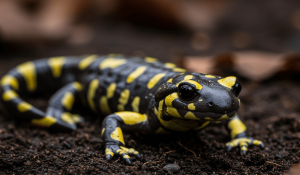
They can be found in all sorts salamander’s such as grasslands and woodlands, throughout the U.S., Canada and Mexico. To escape threats and the sun, they make burrows underground and swim back to water in spring to reproduce.
Pets need a 20-gallon terrarium with soil that can be dug into and clean water and should be fed live insects and worms sprinkled with calcium and vitamin D3. They do best when the room is warm and humid.
“Tiger salamanders are a prime example of the incredible adaptability and resilience of amphibians, as they seamlessly transition between aquatic and terrestrial environments throughout their lives.”
Tiger salamanders are a good illustration of how amphibians can quickly go from living in water to living on land. Knowing how to care for them and what they need supports their health, whatever their environment. To learn more about tiger salamanders, check out the Wikipedia page on them.
Axolotl
Species Names: Ambystoma mexicanum
The Mexican walking fish, which is another name for the axolotl, is a distinct salamander. A lot of pet lovers and scientists have been captured by it. They are found in the water systems of Mexico City. A notable characteristic of theirs is neoteny, which means they never lose their juvenile characteristics and spend all their lives in water.
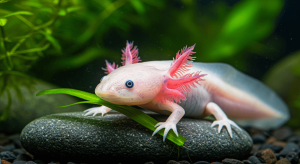
Unique Features and Adaptations
There are many special aspects to axolotls. The gills on their heads let them breathe while they are underwater. The heads are also broad, with a long neck means they have an unusual appearance. It’s interesting to scientists that axolotls can replace lost body parts, including limbs and organs.
Axolotls are essential in the wild. They like to feed on insects, crustaceans, and small types of fish. They recognize food by its smell, and their large mouths let them catch it quickly. In addition, they break down natural materials and assist the growth of both plants and tiny living organisms.
Axolotl Care and Tank Setup
Are you thinking about including an axolotl in your family as a pet? You should understand how to raise them. They should have a tank that feels comfortable for them. These tips will help you set up their tank:
- Tank size: Get a tank of at least 20 gallons for one axolotl, plus 10 gallons for each more.
- Water parameters: Keep the water at 60-64°F, pH 6.5-7.5, and make sure there’s no ammonia or nitrite.
- Filtration: Use a good filter to keep the water clean and remove waste.
- Substrate: Use a soft and sand-like substrate to not hurt their skin or gills.
- Decorations: Place hiding spots, such as caves or plants, in their home to keep them interested.
Please provide them with a variety of special pellets, earthworms, bloodworms, and raw fish in small pieces. They eat very slowly and may become too obese, so do not overfeed them.
Axolotls can be wonderful pets under the right conditions. They have been friendly and elegant and very good at their craft. That difference makes them one of the wonders of the salamander world.
Spotted Salamander
Species Name: Ambystoma maculatum
Amphibian enthusiasts have become fond of the spotted salamander. They are famous for their lively colors and unusual features. They’re a good option for anyone interested in helping salamanders and owning one as a pet.
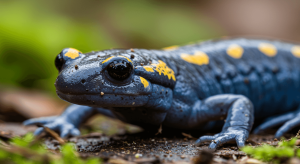
Identifying Spotted Salamanders
You can easily tell spotted salamanders apart because of their noticeable color and patterns. Black or bluish-black is their usual color and are covered with bright yellow or orange spots. Most of these spots are found in two uneven rows from the head to the tail. Adult spotted salamanders may grow up to 8 inches long, making them one of the biggest salamanders found in North America.
Spotted salamanders live in deciduous forests spread throughout eastern North America. They are important in the forest food web because they hunt and are hunted by other animals. Spotted salamanders are used to assess environmental health because they notice and can warn us about changes in their habitats.
Creating a Suitable Environment
It is necessary to build a home for your spotted salamander that imitates what they live in nature. The best type of terrarium uses a substrate that helps the soil keep moisture, like coconut fiber or sphagnum moss. Use logs, cork bark, or fake caves to give your salamander a place to hide. A shallow water dish makes it easier to keep the humidity up and helps your pet soak.
Spotted salamanders live best in a cool, humid climate with temperatures between 60 and 70°F (15 to 21°C). Ensure the air in the enclosure is between 70 and 80 percent humid by misting it or using a misting machine. Good lighting is also necessary; you can create a 12-14 hour photoperiod with a low-wattage UVB bulb or by using sunlight filtered through a window.
| Enclosure Size | Temperature Range | Humidity Level |
|---|---|---|
| 20-30 gallons (75-110 liters) | 60-70°F (15-21°C) | 70-80% |
If you build a proper habitat and follow their special care needs, your pet spotted salamander will do well. Proper salamander care and a dedication to their health are the first steps in conserving these amazing animals.
Mudpuppy Salamander
Species Names: Necturus maculosus
The Mudpuppy Salamander is a wonderful amphibian to keep if you want one that lives in water. The region where it is found most is the Great Lakes, the eastern United States and the Mississippi River basin, all in North America. It is very easy to recognize because its strange appearance includes pink or red frilly gills formed when it was still a larva. It gives an exceptional pet experience since it swims constantly and needs a well-cared-for tank to survive.
Care and Habitat
Because mudpuppies live in water, their aquarium should hold clean, cool and properly oxygenated water. A minimum tank size of 30 gallons is needed for them since they reach up to 12-17 inches in length. The substrate in the tank should be soft sand or fine gravel, plus rocks and submerged objects to make it feel like their habitats since mudpuppies like to hide underwater. They are most comfortable in water that is between 50°F and 65°F (10°C and 18°C).
Diet
Mudpuppies are meat-eaters and will do well on a diet of live or frozen foods such as earthworms, small fish, shrimp and insect larvae. They don’t chase their prey but catch it when it happens to move by. A regular diet with different foods helps your pet get the required nutrients.
Temperament
Mudpuppies usually do not attack other fish in the tank. They might not get along with other pets that are smaller and more active, since they can be territorial. Because they are solitary, they should be kept by themselves or with other calm aquatic animals of the same size.
Maintenance
Mudpuppies are not hard to care for, but their water must be changed often to stop waste from damaging the water. Proper health of your pet depends on changing the water and using a good filtration system. Since they like cold water, their tank should not be placed where it could get too warm such as near direct sunlight. Mudpuppies in the wild might live for about 10-15 years and those kept in captivity can live just as long if they are well looked after.
Interesting Facts:
- Neoteny: Mudpuppies retain their juvenile characteristics throughout their entire lives, including their external gills, which make them fascinating to observe.
- Low Maintenance: Unlike many amphibians, mudpuppies do not need to undergo metamorphosis, making them a straightforward pet for those who prefer an aquatic, non-terrestrial animal.
- Unique Look: Their feathery gills and mottled skin are both a striking and unusual feature for a pet amphibian.
Mudpuppy salamanders are not widely kept as pets, but they add a special look to a home aquarium and are well-suited for people interested in unusual amphibians.
Marbled Salamander
Species Name: Ambystoma opacum
Marbled salamanders are a unique species characterized by their strange appearance and breeding behaviors. Salamanders of this type are found in the eastern United States. They can be wonderful pets if you’re familiar with looking after amphibians.
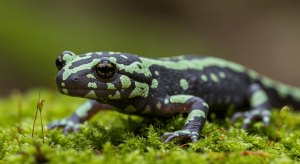
Marbled Salamander Appearance and Behavior
You can easily notice marbled salamanders because of their black and white stripes. This camouflaging creates a disguise to blend with the leaves of the forest floor. Having the right color is an important way for them to stay safe.
These salamanders are found most often on the ground and they are nocturnal. Most of the time, they can be found under logs, under rocks or buried in leaf litter. They root around for insects and worms at night.
Breeding and Raising Marbled Salamanders
Marbled salamanders have an interesting breeding system. Come fall, they deposit eggs on land, typically in drier locations or below logs. The females protect the eggs until the rains arrive and the area is flooded. The eggs then develop into larvae, which are aquatic.
A terrarium needs to be set up to look and feel just like a marbled salamander’s natural environment. A coconut fiber or sphagnum moss substrate will help your plants hold moisture. Include some places for your pet to hide and make sure there is a dish of shallow water for them to drink and soak.
If you decide to breed your pets, you’ll have to provide a special environment. There should be parts of the nest for egg-laying and raising the larvae. A thick layer of substrate is necessary for the eggs to be laid and you’ll need to flood the tank when the eggs hatch.
Marbled Salamanders make awesome pets because they look a bit different and have interesting breeding behaviour. However, they require proper care from their owners.
Chinese Giant Salamander
Species Name: Andrias davidianus
The Chinese giant salamander is different from other amphibians in every important way. It is the biggest salamander species in the whole world. Some may grow to 5.9 feet (1.8 meters) and weigh as much as 110 pounds (50 kilograms). Because of their big size and unusual look, they are now close to extinction in the wild.
Chinese giant salamanders in the wild are being seriously threatened by the loss of their habitats, poaching, and pollution. Because of this, very few of them are left. Steps are being taken to save both animals and their habitats. However, many actions are needed to stop them from becoming extinct. Taking care of the Chinese giant salamander helps many other endangered species.
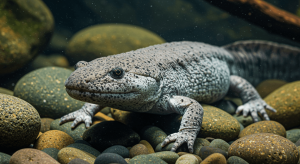
Before getting a Chinese giant salamander as a pet, it’s important to realize how much extra care they need. They need a big, specially built home that mimics where they naturally live. It must include filters and use clean water. It is essential for their health and happiness.
A big appetite means Chinese giant salamanders are hunters of fish, crustaceans and small mammals. It’s a big responsibility to keep them healthy by offering them lots of different foods.
Experienced keepers are only encouraged to get a Chinese giant salamander as a pet. They need a lot of space to be happy, and their maintenance must be sophisticated.
Before you get a Chinese giant salamander, be sure you know everything about them. Check if you can offer enough care, time and dedication for a pet before you get one. If held in a zoo or aquarium, they might live well over half a century.
| Characteristic | Details |
|---|---|
| Size | Up to 5.9 feet (1.8 meters) in length, over 110 pounds (50 kilograms) |
| Conservation Status | Critically Endangered |
| Enclosure | Massive, custom-built setup with proper filtration and water quality maintenance |
| Diet | Large prey items such as fish, crustaceans, and small mammals |
| Lifespan | Can exceed 50 years in captivity |
Salamander Species Diversity
More than 700 species of salamanders are found in the ten different families that make up their world. Each family has its own uniqueness, strengths, and skills they are adapting to. They demonstrate the vast diversity found in amphibians of the order Caudata. When you look into salamander families, you see a variety of forms, sizes, colors, and ways they live.
Exploring Different Salamander Families
Members of the Salamandridae family are true salamanders and newts. The group known as Ambystomatidae includes mole salamanders. The members of this family, Plethodontidae, do not have lungs. They demonstrate the huge diversity found within the caudata group.
The family Salamandridae includes the fire salamander and the Japanese fire belly newt as its popular pet salamanders. People recognize these species for their colorful and patterned bodies. Many reptile and amphibian fans like them best.
The family Ambystomatidae is where mole salamanders are found. Many people have heard of the tiger salamander and the axolotl. All of them have different ways they survive and stories to tell.
Plethodontidae, or lungless salamanders, are the most prominent family of salamanders. More than 60% of all salamanders belong to the family. They don’t have lungs and instead use their skin and mouth to take in oxygen.
Rare and Endangered Salamander Species
Quite a few salamander species are endangered. A decline in many populations is happening due to habitat loss, pollution, and climate change. Particular species are very close to becoming extinct.
The Chinese giant salamander is the largest amphibian in the world and can grow up to six feet long. But pollution, overharvesting, and habitat destruction have pushed it to the brink of extinction.
The following salamander species are also threatened:
- The Appalachian salamander, found only in a small region of the eastern United States
- The Java giant salamander, endemic to the island of Java in Indonesia
- The Gorgan salamander, restricted to a small area in northern Iran
Conservation is important to ensure the survival of these threatened species. If we are willing to appreciate what sets each species apart from the other, we can help ensure that each one has a better chance at survival in the future.
| Salamander Family | Notable Species | Unique Characteristics |
|---|---|---|
| Salamandridae | Fire salamander, Japanese fire belly newt | Vibrant colors, striking patterns |
| Ambystomatidae | Tiger salamander, Axolotl | Unique adaptations, fascinating life histories |
| Plethodontidae | Red-backed salamander, Ensatina | Lungless, cutaneous respiration |
Setting Up a Salamander Habitat
A proper habitat for your pet salamander makes it healthier and happier. It’s important to focus on a few points when preparing to keep a salamander. It helps your salamander feel at ease with lots of things for it to do.
Choosing the Right Enclosure
You should ensure you have the proper enclosure for your salamander. They are good pets to have in glass terrariums or aquariums. The size depends on the salamander’s size. For every 4 inches of your salamander’s body, make sure the tank is at least 10 gallons. Make sure you provide a tight-fitting lid with adequate ventilation to avoid the possibility of your salamander escaping.
Substrate, Decoration, and Plants
It’s important that the substrate holds water and allows your pet salamander to tunnel. Coconut fiber and sphagnum moss, or using them together, are all good options. Gravel and sand are dangerous for salamanders, so don’t add them to the enclosure. Adding rocks, logs, and plants will help the habitat look more like home. They help your pet hide and keep the right level of humidity in the tank.
While decorating, think about what your salamander will make use of. Choose items for your home that help with keeping the air moist.
Lighting and Temperature Control
For your pet salamander to stay healthy, you should regulate both lighting and temperature in the tank. Unless your salamander is a turtle, most species do not need UVB lights, but check with your pet’s species first. Place a heat lamp where your pet can rest if it’s cold, and check the temperature often with a thermometer. Maintain the temperature so it is similar to where your salamander lives.
| Salamander Species | Temperature Range (°F) | Humidity Range |
|---|---|---|
| Tiger Salamander | 65-75 | 60-80% |
| Spotted Salamander | 60-70 | 70-90% |
| Marbled Salamander | 60-70 | 70-90% |
Remember these tips when setting up your salamander’s home:
- Keep the humidity right by misting the enclosure often
- Have a shallow dish of water for soaking and drinking
- Clean the enclosure often to stop harmful bacteria from growing
- Don’t put too many decorations or plants in the habitat
If you build a good and clean salamander habitat, your pet will be in good spirits and healthy. Research the special needs of your salamander and change the habitat accordingly.
Feeding Your Pet Salamander
It is important to know your salamander’s diet and ensure they are being fed right. Salamanders eat differently based on both their species and the place they live in. If you feed your salamander foods it would eat in nature, you help it remain happy and healthy.
Salamander Diet in the Wild
Salamanders eat insects, worms, and small animals in the wild. Their senses are sharp enough to help them hunt prey. The fire salamander and similar amphibians sometimes eat small fish, snails, and slugs.
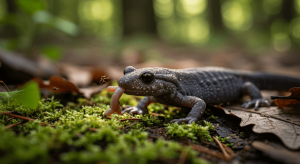
Figure out what your salamanders naturally eat outdoors to feed them indoors properly. You may feed your pet foods that are similar to what they might find in nature. Research what is the best diet for your pet salamander to stay healthy.
Providing a Balanced Diet in Captivity
It is essential to feed your pet salamanders food that they would eat in the wild. You should feed your pet mainly live worms, mealworms and crickets. They support animals in finding and eating what they need to stay healthy.
You might also feed your salamanders special gel foods for salamanders or amphibian pellets. All the vitamins and minerals your pet salamander needs come from these products. Most of their diet should consist of live insects since only some salamanders like to eat other foods
“Feeding your pet salamander a diverse and nutritious diet is key to their health and longevity. By offering a variety of live insects and supplementing with commercial foods when appropriate, you can ensure your salamander thrives in captivity.” – Dr. Jane Smith, Herpetologist
Here are some tips for feeding your salamander:
- Give them prey that’s the right size to avoid choking or stomach problems
- Put calcium and vitamin supplements on live insects for extra nutrition
- Feed them every 2-3 days if they’re adults
- Take out any food they don’t eat to keep their home clean
A salamander will remain healthy and grow if you offer it food it could find in nature. Feed your salamander the proper meals, and if you’re not sure what they should eat, call your reptile vet for help.
Common Health Issues in Pet Salamanders
Salamanders will get sick if you don’t give them proper care. It matters to understand these problems and try to solve them. Looking after your pet well will keep it healthy and support salamander conservation.
Many salamanders develop respiratory problems. Pollen can be released whenever there’s dirty water, little air circulation, or very hot or cold temperatures. Signs you should watch for are tiredness, loss of appetite, and difficulty breathing. You can prevent these infections by making their home clean, ventilated and at the right temperature.
Different skin problems are very common. They can be little cuts or lead to infections. Lessen the amount you handle your pet and make sure their house is always tidy. If your pet’s skin is not healthy, make an appointment with a vet who knows amphibians.
A lot of salamanders suffer from metabolic bone disease (MBD). Not getting enough vitamin D3 and calcium is what causes it. It might lead to weak and deformed bones. Give your pet foods that are rich in calcium, and use any calcium supplements your vet talks about.
“Regular check-ups with a veterinarian experienced in amphibian care are crucial for maintaining the health and well-being of your pet salamander. By detecting and addressing potential health issues early on, you can ensure that your salamander receives the appropriate treatment and care.”
Other health issues can affect salamanders too, like:
- Parasitic infections
- Nutritional deficiencies
- Stress-related disorders
- Injuries from improper handling or habitat setup
By keeping their home clean and neat, you can prevent these problems. Serve them the right meals and treat them nicely. Regular visits to the vet are necessary for your pet salamander and it should begin treatment. get medical care as fast as possible for any health issue.
| Health Issue | Symptoms | Prevention |
|---|---|---|
| Respiratory Infections | Lethargy, loss of appetite, difficulty breathing | Maintain clean, well-ventilated habitat with appropriate temperature and humidity |
| Skin Problems | Redness, swelling, white patches | Keep habitat clean, avoid excessive handling, consult veterinarian if issues arise |
| Metabolic Bone Disease (MBD) | Weakened bones, skeletal deformities | Provide balanced diet with calcium-rich foods and vitamin D3, offer calcium supplements as needed |
You can take care of your salamander’s health if you know about these health concerns and how to avoid them. Taking care of your pet is crucial for both you and the salamanders in general.
Conclusion
This article covers the world of pet salamanders. We have explored the ten best species for those interested in strange creatures. Every salamander, especially the Fire Salamander and the Axolotl, has something fascinating about it.
It’s possible to build a good home for your pet salamander if you understand its needs. You must know how to look after them, where they live, and what food they enjoy most. You support their health and happiness by doing this.
It is fun to have a salamander as a pet. You can see these animals closely and discover how they live. However, make sure you have the time and patience to provide for them for many years.
Check what a pet salamander needs before you decide to have one. Their home, their food, and their care are all included in this. You have to be prepared for this to happen.
If you are a salamander owner, keep learning about them. Find out their needs, what they enjoy in their home, and how to look after them. You and your salamander can have a close bond with the proper care.
You can find out about several types of salamanders living across the globe. We only mentioned ten, but there is even more to find. Please keep discovering and learning about these fascinating animals. We can also help protect them in the wild and our homes.
FAQ
What makes salamanders great pets?
Salamanders help you understand more about amphibians. They live in many various forms and patterns. That’s why they are both enjoyable and informative to keep as pets.
What should I consider before getting a pet salamander?
Check how to care for a salamander before you get one. They must create their home, manage their diet, and ensure their environment is right for them. You should be able to provide for your pets for their whole lives.
What is the difference between salamanders and newts?
Caudata includes both newts and salamanders. Newts are classed as salamanders, but they prefer to live in water. Rather than salamanders, toads have dry skin, and their ear openings are visible.
How do I set up a proper habitat for my pet salamander?
The habitat needs vary by salamander species. You’ll need a large enclosure with good air flow, a substrate that holds moisture, hiding spots, and decorations that mimic their natural home. Some need an aquatic setup with filters and basking areas.
What do pet salamanders eat?
In the wild, salamanders eat a variety of things like insects, worms, and small invertebrates. As pets, feed them a balanced diet of live insects, earthworms, and amphibian pellets that match their natural diet.
Are salamanders easy to care for?
Salamanders can be great pets but need special care. They have specific needs for their habitat, diet, and environment. Some are harder to care for than others. Choose a species that fits your experience and commitment.
Can I handle my pet salamander?
Handling your salamander should be kept to a minimum to avoid stress and harm. Always use clean hands when handling them. This protects their protective skin layer.
How long do pet salamanders live?
The lifespan of a salamander depends on the species. Some live a few years, while others can live up to 20 years or more. Know the lifespan of your species and be ready to care for them for their whole life.
